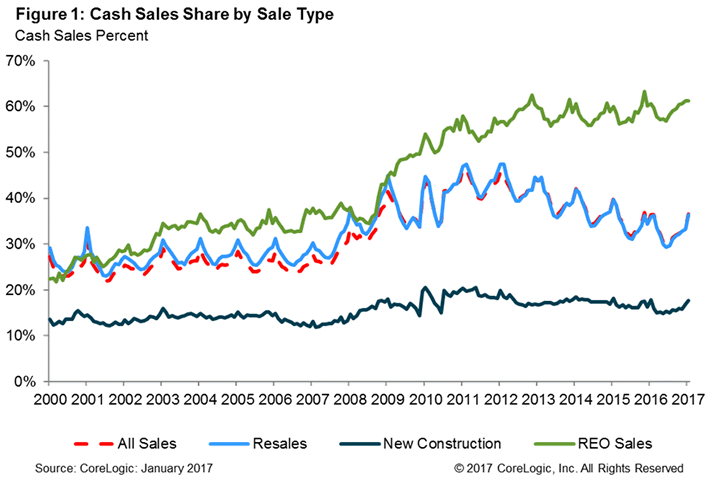The share of sales that are all-cash continues at an elevated level. CoreLogic reports cash transactions accounted for 36.5 percent of all home sales in January, unchanged from a year earlier. While the percentage of sales that close without third-party financing has declined from the January 2011 high of 46.6 percent, it remains well above the pre-crisis average of around one-quarter of sales.
Sales of bank-owned property (REO) had, as they always do, the largest share of cash transactions, 61.2 percent. Resales had a cash share of 36.5 percent and new homes a 17.7 percent share.

Alabama had the largest cash sales share of any state at 52 percent, followed by New York (49.7 percent), Florida (48.3 percent), Indiana (46 percent) and Missouri (45.4 percent).
Sales of distressed properties made up only 7 percent of home sales in January, with sales of REO accounting for 5.9 percent and short sales 1.1 percent. The overall distressed sales share represents a year-over-year decline of 4.6 percentage points and is the lowest share for any month since September 2007. Pre-crisis, distressed sales traditionally accounted for about 2 percent of home sales. CoreLogic says that the current rate of decrease should bring distressed sales down to that "normal" 2-percent mark by early-2018.
When it peaked in January 2009, the distressed sales share of home sales was 32.3 percent, with sales with REO representing 27.9 percent. The shrinking REO percentage is the primary reason cash sales have declined.
All but eight states recorded lower distressed sales shares in January 2017 compared with a year earlier. Connecticut had the largest share of any state at 17.3 percent, followed by Maryland (16.3 percent), Michigan (15.1 percent), New Jersey (15.1 percent) and Illinois (12.8 percent). North Dakota had the smallest distressed sales share at 1.2 percent.







